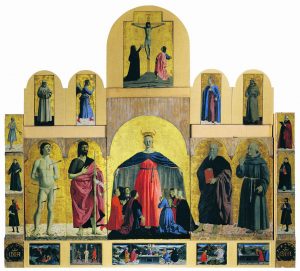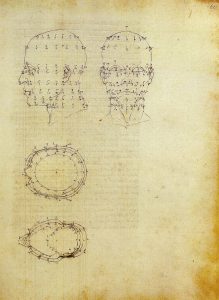Piero di Benedetto dei Franceschi, was a painter whose serene, disciplined exploration of perspective came to be recognized in the 20th century as a major contribution to the Italian Renaissance.

Known by his contemporaries mainly as a mathematician and surveyor, today Piero della Francesca is recognized above all for his art. In particular, his painting is characterized by its humanism, the use of geometric shapes, and perspective. His most famous work is the frescoes cycle The History of the True Cross in the church of San Francesco in Arezzo.
Training and early life
The artist was born around 1415 in Sansepolcro and here he began his training as a painter under Antonio di Anghiari. Early in his career, della Francesca moved between his hometown and the main courts in northern Italy, including the Malatesta family in Rimini, the Medici family in Florence, and the Montefeltro family in Urbino. In 1445, he was commissioned by the confraternity of Misericordia to paint the Polyptych of the Misericordia, which he painted in part until 1462. The central figure, is the Virgin Mary, looking straight at the viewer, placed on a gold background and opening her black cloak to her worshipers.

Image source:https://search.creativecommons.org/photos/7b7deee8-a74a-4504-b76e-953744f8a621 by Anam il Senzanome
Style analysis with The Baptism of Christ

Image source:https://commons.wikimedia.org/wiki/File:Piero_della_francesca,_battesimo_di_cristo,_1450-60_ca._01.jpg
The Baptism of Christ is a good example of the style of Piero della Francesca. Baptism takes place within an arched frame, in a landscape similar to the countryside around San Sepolcro. In 1442 Piero della Francesca is remembered as a municipal councilor in Borgo San Sepolcro. In this work, Christ is depicted in the act of being baptized by John, with his head surmounted by a dove (the Holy Spirit). Christ, John’s hand, the bird, and the bowl form an axis that divides the painting into two symmetrical parts while a second division according to the golden ratio is created by the tree on the left. The three angels wear different clothes and, unlike traditional iconography, they do not hold Christ’s robes, but hold hands.
Mature period
The mature style of Piero della Francesca emerges in the frescoes painted in the choir of the church of S. Francesco at Arezzo. In 1466 the narrative cycle The Legend of the True Cross was completed. Typical of Piero’s art are the controlled use of perspective, the simplicity and clarity of structure, and the aura of serenity. A fresco of the Magdalen in the cathedral of Arezzo, the Madonna del Parto in the chapel of the Monterchi cemetery, and the Resurrection in the Palazzo Comunale of Sansepolcro are contemporary to the Arezzo cycle.

Image source: https://en.wikipedia.org/wiki/The_History_of_the_True_Cross
An altarpiece for S. Agostino was commissioned in 1454 by Agnolo di Giovanni di Simone d’Angelo, a bourgeois from Sansepolcro, and this work was not completed by Piero until 1469. Piero’s interest in creating monumental human figures is revealed in the surviving panels of the altarpiece through sculpture the use of line and light.
Resurrection, the most beautiful painting
An example of the perfect union between art and science is the Resurrection in the Palazzo dei Conservatori, historically the seat of the Municipality of Sansepolcro and today the Civic Museum. In the fresco, the figure of Christ is placed in the center of the scene, strong and solemn in front of the viewer, and he is the one who triumphs over the darkness of the tomb and the ignorance of men, becoming both a civic symbol and a sacred icon. The contemporary writer Aldous Huxley called it “the most beautiful painting in the world.”

Image source: https://en.wikipedia.org/wiki/
Later years

Image source: https://en.wikipedia.org/wiki/De_prospectiva_pingendi
In his later years, painters such as Perugino and Luca Signorelli often frequented his workshop. He completed the treatise On Perspective in painting between the mid-1470s to 1480s. In 1480, his vision began to deteriorate, but he continued to write treatises such as Short Book on the Five Regular Solids in 1485. It is documented that Piero rented a house in Rimini in 1482, he made his will in 1487 and died on 12 October 1492, in his own house in San Sepolcro, leaving his possessions to his family and the church.
Info sources: https://www.britannica.com/ https://en.wikipedia.org/wiki/The_Resurrection_(Piero_della_Francesca http://www.travelingintuscany.com/art/pierodellafrancesca.htm https://www.visittuscany.com/
